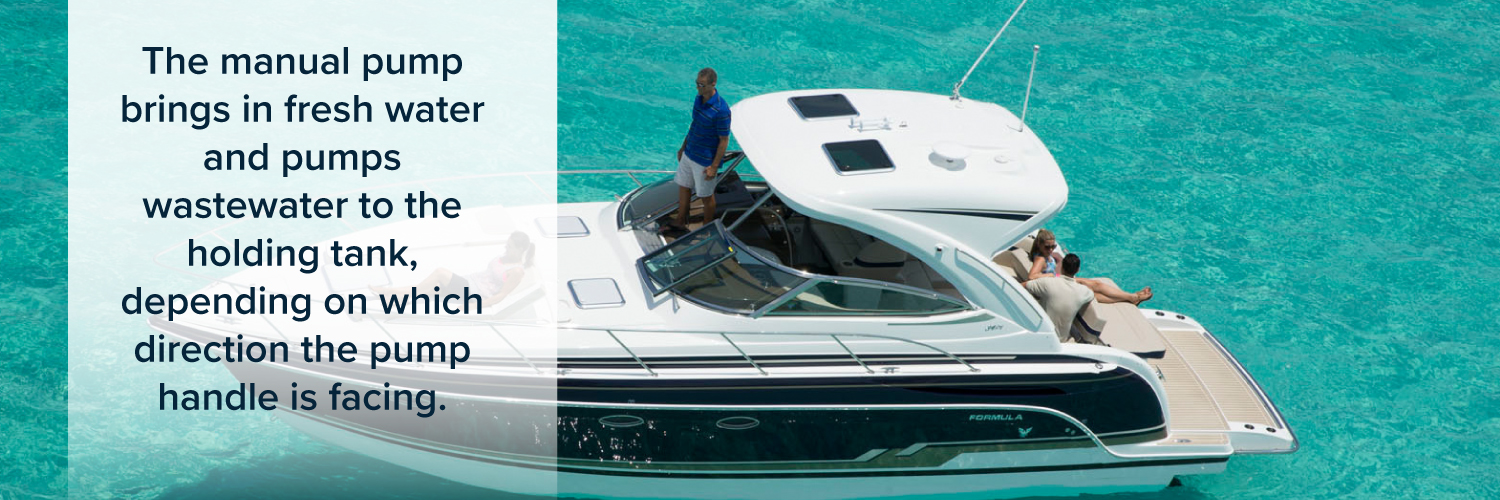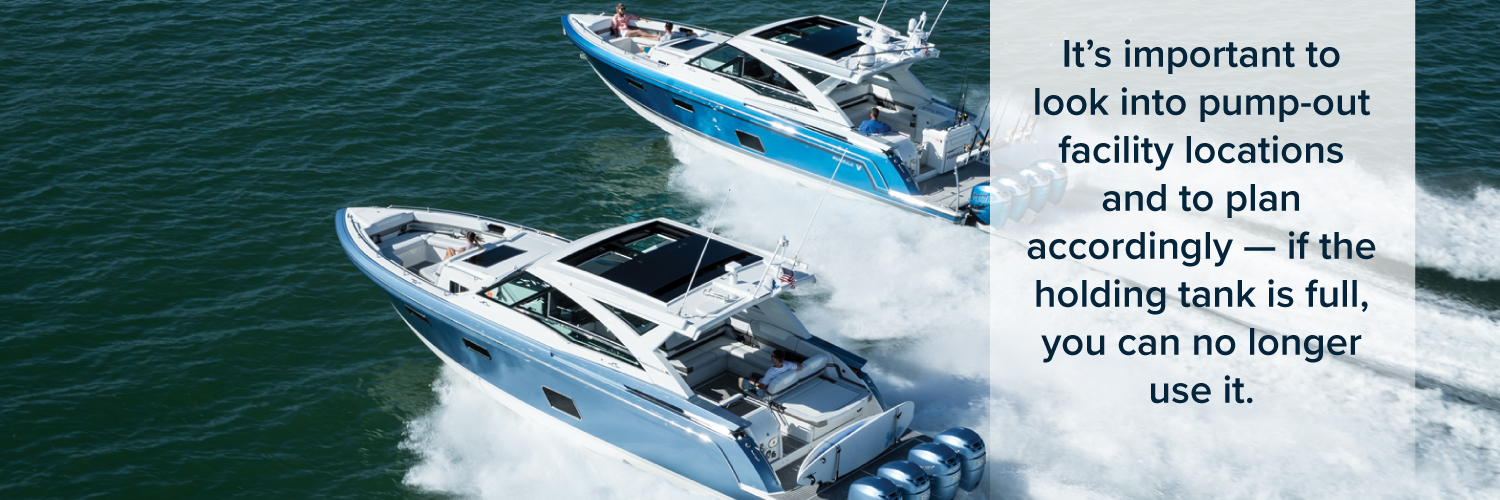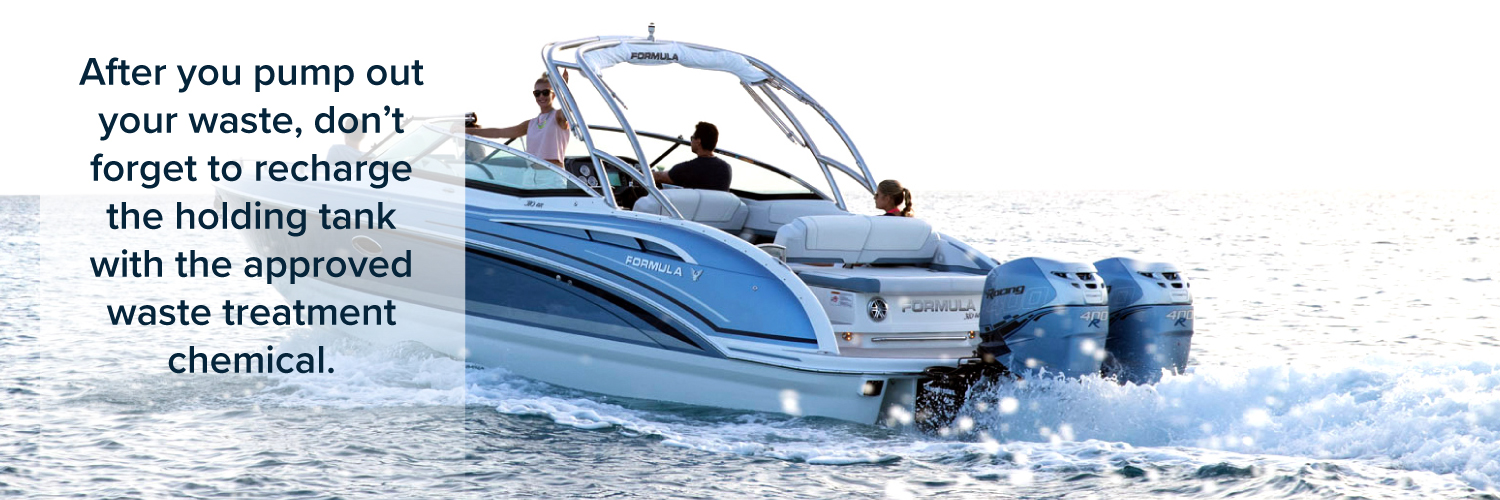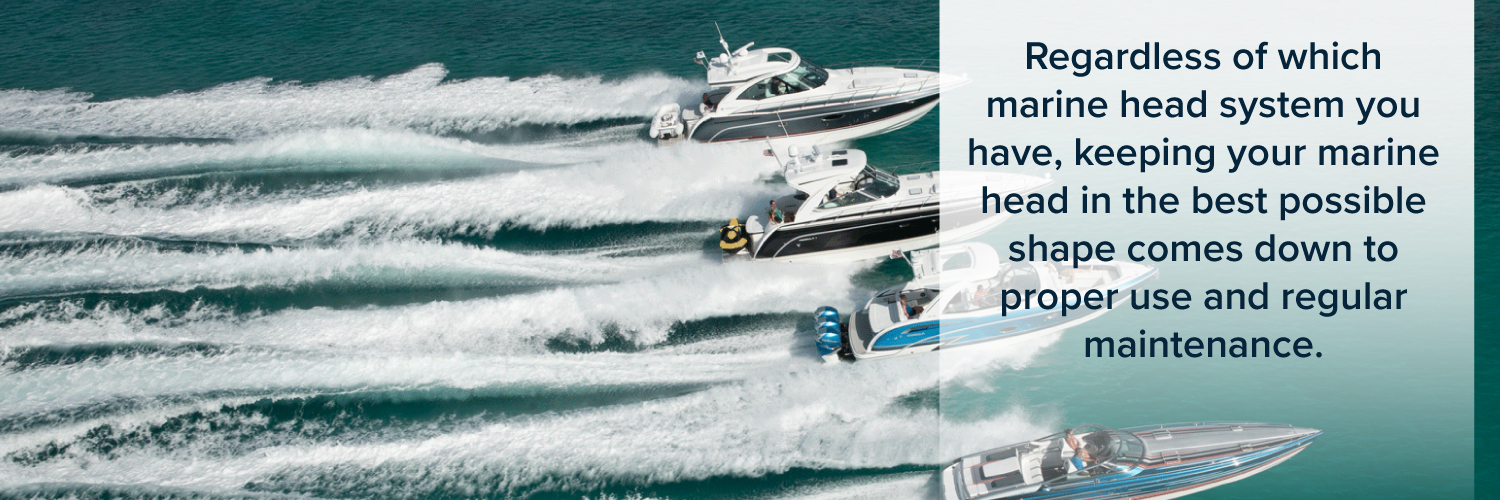Choosing a marine toilet, also known as a head system, is not an easy feat. There are a variety of marine sanitation systems that all work a little differently and come at a range of price points. Once you’ve chosen the head system for your boat, you need to keep up with maintenance — while the overall upkeep is similar, the specifics ultimately depend on the type of system you choose. Plus, you need to know the laws surrounding head systems and when and where you can and cannot dump waste.
The best thing you can do is educate yourself on the types of head systems available, how they work and the laws surrounding the use of head systems. We’ve included information on all this below to help you get started.
Types of Head Systems
While there seems to be an endless number of head systems, we can group the majority of them into three main categories based on their structure and function — self-contained portable toilets, fixed plumbing systems with holding tanks and marine sanitation systems.
Self-Contained Portable Toilets
If you’re limited on space and need a way to hold a small amount of waste — usually a maximum of six gallons — and aren’t feeling disgusted by the thought of manually taking that waste off the boat and onto shore to dump, a self-contained portable toilet may work for you. This type of marine toilet is a small porta-potty for your boat — no permanent plumbing needed, low risk of clogging and the most inexpensive type of marine toilet.
The cons? Deodorizing chemicals may not be able to tackle the smell, and you’re going to have to physically carry the container with the waste off the boat to dump — either in a marina toilet or to a pump-out facility where personnel will dispose of it for you.
Fixed Plumbing Systems With Holding Tanks
If you aren’t keen on the upkeep of the porta-potty, the next step would be a fixed plumbing system with a holding tank. Within this category, there are a few different options. All of them share a few things in common — a holding tank and a system of hoses and valves. Where each of them differs is in the operation and discharge options.
- Manual pump: A manual pump, like the Jabsco units in some of our Formula Boats models, uses raw water, requiring you to open an inlet seacock. The manual pump brings in fresh water and pumps wastewater to the holding tank, depending on which direction the pump handle is facing.

- Electric pump: These pumps, like the Vacuflush units available in the majority of Formula Boats models, use the freshwater system of your boat for their water supply and flush using a vacuum generated by an electric pump and a vacuum holding tank. To use this type, you need to turn on the waste system and/or the head pump breakers at the cabin electrical panel. Lift up on the flush lever to draw some fresh water into the bowl. Then, to flush, push down on the flush lever. The vacuum draws the waste through a constricted opening at the bottom of the head, fragmenting it before it travels to the holding tank.
Once you’ve decided which type of operation you prefer, the next step is to choose a plumbing system configuration — that is, what discharge options you want to have.
- Pump-out holding tanks: Holding tanks may exclusively come with a pump-out option. This type — sometimes referred to as a coastal holding tank — is meant for those who use pump-out facilities 100 percent of the time and do not have a need for a self-discharge option. If you use your boat within three miles of the coast, you can’t legally discharge your waste overboard, so this option may be the perfect match for your use. It’s important to look into pump-out facility locations and to plan accordingly — if the holding tank is full, you can no longer use it.

- Pump-out holding tanks with overboard discharge option: If you’re choosing a marine head system for your boat, travel in areas where dumping waste is legal and want to have the option to discharge overboard, this is a great option. Sometimes called an offshore or coastal hybrid tank, this model has a Y-valve located between the toilet and the holding tank, giving you the option to switch it to discharge overboard if and when it’s legal, or keep it switched to the holding tank when you’re in areas where dumping is illegal. The downside to this model is the risk of accidental discharge, which authorities don’t like to see. Plus, if the holding tank is full, your head will be out of order.
- Holding tanks with multiple options: This one is the most versatile holding tank head system and the one we’ve chosen as the standard in all our Formula Boats Cruiser and Super Sport models. In this type, all waste goes from the toilet through a hose and into the holding tank. The Y-valve gets installed after the holding tank, giving you the opportunity to store waste in the holding tank and then either use a pump-out facility or discharge through a macerator pump when you legally can. Many wonder, “How does a macerator pump work on a boat?” The answer is that when you switch the Y-valve to discharge the holding tank, it goes out through a macerator pump, which grinds up all the waste before discharge. This option is available in Formula Boats models through the addition of the optional macerator system.
Marine Sanitation Systems
The third type of head system is marine sanitation systems — these systems do not need a holding tank because they treat the waste to eliminate harmful bacteria and contain a macerating pump, which grinds the waste into sludge and discharges it overboard. Due to the complexity of these marine sanitation systems, and their price tag, they are usually on large, live-aboard boats. Despite the fact that these systems sanitize the waste, and make dumping waste legal in most cases, boaters with these systems are still required to observe the No-Discharge Zones designated by the Environmental Protection Agency.
Tips for Dealing With Holding Tanks
Unless you’re interested in a porta-potty or own a large, live-aboard yacht, choosing a marine toilet often involves learning how to use and maintain a holding tank, also called a waste tank. While these tanks are certainly manageable, they are not something boat owners can afford to neglect. Here are a few key things to keep in mind if you have a head system with a holding tank.
Monitor Your Holding Tank Level
This may seem like a no-brainer, but make sure you are aware of how full your holding tank is and pump it routinely. While tank indicators may differ slightly, all of them clearly show when your tank is full. In Formula Boats models, we’ve equipped them with a safety mechanism that shuts down the head pump, which disables the toilet’s flush when the waste tank is full. While it may seem like a nuisance, the purpose is to protect you from overfilling the tank and creating a mess.

Recharge with Waste Treatment Chemicals
After you pump out your waste, don’t forget to recharge the holding tank with the approved waste treatment chemical. While your holding tank system isn’t a marine sanitation system, there is still some level of sanitation and breakdown involved when you’re dealing with waste. Flushing it through the head system can also help. For specifics, follow the instructions in your marine toilet manufacturer’s operation manual.
Don’t Forget About the Seacock
If you can discharge through a macerator pump legally, don’t forget to open this valve. Otherwise, your macerator will be trying to pump waste with no place to push it. The result could be a burned-out macerator — or, if a fitting gives out, the creation of a brand-new holding tank: your engine compartment.
Use Deodorizers Regularly
It shouldn’t come as a surprise that smells can accumulate in a holding tank over time. Rather than waiting until a smell develops, use deodorizers regularly to help prevent a problem from arising. Again, for specifics on what to use and how often, it’s best to consult your marine toilet manufacturer’s operation manual.
Marine Head Maintenance Tips

Regardless of which marine head system you have, keeping your marine head in the best possible shape comes down to proper use and regular maintenance — and replacement, as needed. If you are diligent in these areas, you will be able to avoid marine toilet problems and extend the life of your head system. Here are a few specific tips we have for maintaining your marine head.
Educate Guests On Marine Head Etiquette
Yes, toilet talk before you head out on a boating adventure may be awkward, but what’s even worse is having to pick your guests’ unmentionables out of a clogged head in the middle of your fun getaway. If they don’t own a boat with a head, chances are they don’t know — and so it’s your job to educate them. Just like with a toilet on land, you shouldn’t flush anything except toilet paper and human waste. Period.
Flush Waste Using Freshwater
If you have a Vacuflush head, this tip is easy because your unit uses the freshwater system of your boat for its water supply. For all others, it’s tempting to use raw water — it surrounds your boat and doesn’t require any additional effort. Unfortunately, all the microorganisms that live in raw water, combined with waste, creates a stench that will leave your friends running in the opposite direction. Instead, use freshwater. Keep a few jugs of water in the head compartment and set the intake level to “dry” or “dry flush.” Then use about half of a half-gallon jug for liquid waste and one entire half-gallon jug for solid waste.
Keep It Clean
Whenever you dump out the holding tank, fill the toilet bowl with clean water and flush. Next, pump out the holding tank. If you have a macerator pump, use it. Every so often — especially when leaving the boat for a long time — use more water and diluted, biodegradable detergent to clean the system. A gallon or two will suffice for a self-contained portable toilet. For Formula Boats models, five gallons is enough for the manual pump head and Vacuflush heads. Run it through all the parts of your system to remove sludge and debris and to prolong the lifespan of your equipment. In your cleaning efforts, never use harsh chemicals like commercial drain cleaners, which will corrode your seals and hoses.
Get A Repair Kit
Purchase a repair kit with parts specifically for your make and model of marine head — it’ll contain flapper valves, joker valves and seals, plus other parts that could fail. Then, whether you’re in the middle of a day on the water or in between seasons, you have the parts you need to complete a repair and won’t get stuck without a working marine head.
Winterize It Properly
If you’re getting your boat ready for winter, make sure to fully drain all water from all freshwater lines, as well as the head and holding tank. Add non-toxic RV antifreeze to the freshwater tank and flush a sufficient amount of antifreeze through the hoses and into the holding tank. Avoid using alcohol-based antifreeze, as it can create tiny holes in the sanitation hoses and lead to an odor problem. When you’re getting your boat ready for a new season, check the tightness of all hose clamps, install a new holding tank vent filter and scrub holding tank sensor probes with a hard-bristled brush.
Replace Parts Wisely
At some point, you’ll need to replace the parts of your marine head system. When you do, make sure you do your homework. While it may be tempting to choose a cheap option, investing in the high-grade hoses can make a big difference, as they will not absorb the smell as easily.
Discharge Laws
As a boater, it is your responsibility to know the federal regulations, as well as any local regulations regarding marine head systems and discharge in your area. We can’t speak to all the local laws where you live, but we can give you an overview of the federal regulations.
Federal regulations on marine head systems came from concerns regarding the bacteria and pathogens in human feces. Many people swim in and drink the water inland and in coastal waters — so the federal government determined it would not permit the presence of this untreated sewage in these areas.
In 1972, the government banned the discharge of untreated sewage into inland waters — including rivers, lakes, etc. — or coastal waters within three miles of the shore. That means unless you have a marine sanitation system, which translates to treated sewage, you are not allowed to discharge any waste within three miles of the coast and in rivers, lakes and other inland waters.
The EPA has also established No-Discharge Zones, where no discharge of any waste — treated or untreated — is permitted. Make sure you know the No-Discharge Zones in your area and avoid discharging any waste in those areas.
If you have a marine head system with a Y-valve between the toilet and the holding tank, the U.S. Coast Guard and most marine law enforcement agencies require the Y-valve to be padlocked to the holding tank position while in use in coastal waters. This requirement is meant to protect against accidental discharge in an area where the discharge of untreated sewage is illegal.
By familiarizing yourself with the federal and local regulations, you can ensure you’re operating your marine head system safely and legally and doing your part to keep the environment clean.
Choosing a Head System for Your Custom Boat
Selecting a head system for your boat is essential, as you want to make sure you have one that gives you what you need to abide by the regulations, but also to add convenience to your boating adventures with family and friends. As a boat manufacturer for more than 40 years, we have experience with a variety of head systems and have selected those that are the best balance of convenience, affordability and safety for our customers.
Formula Boats gives you the ability to customize boat models, empowering you to choose everything from the head system to the paint. Get started with our online boat builder. When you’re ready to take the next step, find the dealer closest to you to begin bringing your custom boat to life. Have questions in the process? Our team is here to help. All you have to do is contact us.
